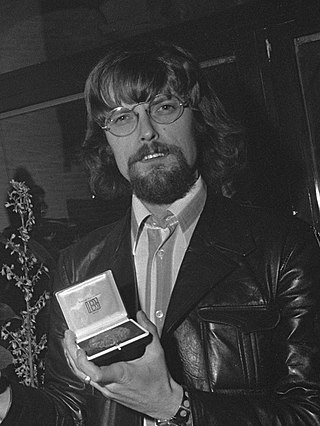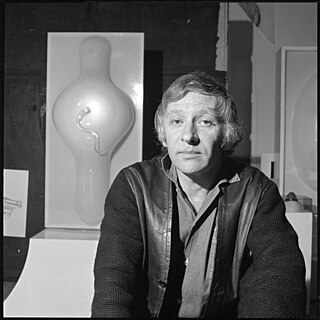
Constant Anton Nieuwenhuys, better known as Constant, was a Dutch painter, sculptor, graphic artist, author and musician.

Jules Adolphe Aimé Louis Breton was a 19th-century French naturalist painter. His paintings are heavily influenced by the French countryside and his absorption of traditional methods of painting helped make him one of the primary transmitters of the beauty and idyllic vision of rural existence.

The Willem de Kooning Academy is a Dutch academy of media, art, design, leisure and education based in Rotterdam. It was named after one of its most famous alumni, Dutch fine artist Willem de Kooning.

Vincent Mentzel is a Dutch photographer, and staff photographer for the Dutch newspaper NRC Handelsblad since 1973. He is known for his photorealism.
Hermanus (Herman) Berserik was a Dutch painter and print maker. He was a member of the Pulchri Studio in The Hague. He studied art at that city's Royal Academy of Art, where his teachers included Willem Schrofer, Willem Jacob Rozendaal, and Rein Draijer.
The Dutch Prix de Rome is based on the originally French Prix de Rome and is awarded annually to architects and artists younger than 35. The award was initiated in 1807 by Louis Bonaparte, then ruler of the Kingdom of Holland, and confirmed after independence by William I of the Netherlands. It was canceled in 1851 by the statesman Johan Rudolph Thorbecke and reinstated in 1870 by William III of the Netherlands. Since then the winners are selected by the Rijksakademie in Amsterdam.

Hermanus Koekkoek, sometimes referred to as The Elder was a Dutch painter, etcher, and graphic artist. He specialized in marine art.

Johannes Jacobus (Jan) van der Vaart was an influential Dutch ceramicist from the 20th century, known as founder of the abstract-geometric ceramics in the Netherlands.
Teunis (Teun) Jacob was a Dutch wall painter and sculptor, who lived and worked in Rotterdam since the early 1950s. He made both figure and nonrepresentational art.

Matthijs Nicolaas Röling was a Dutch painter, active as graphic designer, wall painter, painter, draftsman, lithographer, pen artist, etcher, and academy lecturer. He is considered a kindred spirit of the 3rd generation of the Dutch Group of figurative abstraction. Röling is described as the "figurehead of contemporary figurative painting in the Netherlands."
Daniël (Daan) van Golden was a Dutch artist, who has been active as a painter, photographer, collagist, installation artist, wall painter and graphic artist. He is known for his meticulous paintings of motives and details of everyday life and every day images.

Matheus Josephus Lambertus (Mathieu) Ficheroux was a Dutch artist, who worked as sculptor, glass painter, painter, draftsman, wall painter and installation artist. He is considered among the foremost Dutch artist of the second part of the 20th century.

Cornelis Timmer was a Dutch artist, who worked as sculptor, graphic artist, monumental artist, wall painter, painter, draftsman, jeweler, and mosaicist.
Wouter Bernard (Wout) van Heusden was a Dutch graphic artist, who also worked as etcher, lithographer, manufacturer of woodcuts, painter, draftsman, and painters.

Jules De Bruycker was a Belgian graphic artist, etcher, painter and draughtsman. He is considered one of the foremost Belgian graphic artists after James Ensor and achieved a high level of technical virtuosity. He is best known for his scenes of his home town Ghent, architectural views of cathedrals, war prints and book illustrations.

Jean Pierre François Lamorinière, Jan Pieter Frans Lamorinière or François Lamorinière was a Belgian landscape painter best known for his realistic depictions of landscapes in his home country. His work is situated between the previous generation of the Romantic landscape painters and the Realist landscape.

The Rotterdamse Kunststichting RKS was an independent foundation to promote art and culture in Rotterdam from 1945 to 2005. In 2005 the foundation merged into the Rotterdam Council for Art and Culture, an advisory body, while the other tasks were transferred to the Art and Culture department of the municipality of Rotterdam.
Thomas Meyer zu Schlochtern is a Dutch art historian and curator, who came into prominence as director of the Arti et Amicitiae and as curator at Rotterdamse Kunststichting in the 1990s.

Hendrik Everhart (Henk) Tas is a Dutch visual artist, working as a sculptor, photographer, graphic artist, and wall painter.

Harry van Kuyk was a Dutch graphic artist, visual artist, graphic designer and writer. In 1969 he developed a new technique for the graphic arts, the printed relief or "relief print", a print with an extreme relief.














